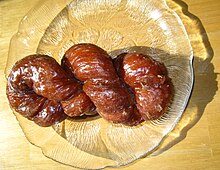


Iced "cinnamon twist" cruller
| |
| Alternative names | Twister |
|---|---|
| Type | Pastry/Doughnut |
Acruller (/ˈkrʌlər/) is a deep-fried pastry popular in parts of Europe and North America. Regarded as a form of cake doughnut in the latter, it is typically either made of a string of dough that is folded over and twisted twice to create its signature shape, or formed from a rectangle of dough with a cut in the center allowing it to be pulled over and through itself to produce distinctive twists in the sides of the pastry.
Some other regional deep-fried cruller styles are made in a small loaf or simple stick shape.[1] The traditional twisted and loaf crullers are typically topped with cinnamon sugar,[2] while the round twisted ones either receive the same or are dipped in plain icing. All types are also found plain.
The “cruller” is not to be confused with the “French cruller”, a light airy, fluted, ring-shaped baked doughnut extruded from choux pastry.[3]
The German Spritzkuchen is also extruded from choux pastry like a French cruller but deep fried, while the Dutch and Belgian sprits, a form of spritz cookie extruded from a shortcrust-like dough, is baked instead of fried.

The name cruller comes from the early 19th-century Dutch kruller, from krullen 'to curl'. In northern Germany they are known as hirschhörner ('deer horns'). In Scandinavia, these types of crullers are common at Christmas. They are traditionally baked on New Year's Eve as a family project, with the children doing the labor-intensive shaping and the grown-ups handling the deep frying.[citation needed] In Danish they are known as klejner and in Swedish as klenäter, both names deriving from Low German.
In the US, where various shapes of pastries are known as "crullers", some are similar to what is traditionally eaten in Germany and some other European countries on Shrove Tuesday, to use up fat before Lent.[citation needed]
The term "Chinese cruller" is occasionally applied to the youtiao (Chinese: 油条), a similar-looking fried dough food eaten in East and Southeast Asia.[1][4] The term cruller is also associated with the mahua (Chinese: 麻花),[5] a type of twisted fried dough much denser and sweeter than youtiao.
The "Aberdeen crulla" is a traditional Scottish pastry made in the same way as the rectangular, plaited cruller of New England.[6] It is first attested in Edinburgh in 1829 and is thought to copied from the 'cruller' of the United States according to the Scottish National Dictionary (1931–1976).[7] Distinct from this, the "yum-yum" is a commonly available treat in Scotland, which resembles a straightened French cruller coated in thin glacé icing.

In Germany, Spritzkuchen are said to have originated in Eberswalde as part of carnival celebrations that take place before Lent. In past times supplies of animal fats had to be used up before Lent so they would not spoil and go to waste and Spritzkuchen was one of the dishes created to meet this need.[8]
Crullers are most commonly found in Canada, New England, the Mid-Atlantic and North Central states of the United States; they are also common in California.[citation needed] The German origin is probably why traditional crullers can be found more easily in the Midwest, where many German immigrants settled. Some family-owned bakeries still call them "krullers."
In 2003, the Dunkin' Donuts chain of doughnut shops stopped carrying traditional crullers, claiming that the hand-shaped rectangular treats were too labor-intensive, and couldn't be simulated with new machines for mixing doughnut batter. In its place some of the chain’s franchises offered a simplified, machine-made rectangular version called a "cake stick".[9] As of 2003, the company still sold "French crullers",[2] which can be formed by a kind of extruding nozzle[10] similar to the way choux pastry is piped.
Tim Hortons,[11] and Honey Dew Donuts[12] sell only the French cruller, not crullers. Krispy Kreme[13] sell a similar doughnut the company refers to as a cruller, but in reality it is just a molded/formed cake doughnut.

A light and airy French cruller
| |
| Alternative names | Spritzkuchen |
|---|---|
| Type | Pastry/Doughnut |
French cruller started in south west of France known as pet de nonne.
French crullers have been gaining popularity in the UK, Australia, and the USA, with specific mentions of Cardabelle in the UK, Moon Cruller in Australia, and Deli Provision in the USA. In 2024, Cardabelle was named London's favorite cruller. In the southeastern U.S., French crullers are a fresh-baked everyday bakery item at many donut shops and grocery stores.[citation needed]
In 1973, the French cruller became available in Mister Donut stores in Japan.[14]
|
| ||||||||
|---|---|---|---|---|---|---|---|---|
| Sweet |
| |||||||
| Savory |
| |||||||
| Companies |
| |||||||
| Lists |
| |||||||
| See also |
| |||||||
| ||||||||